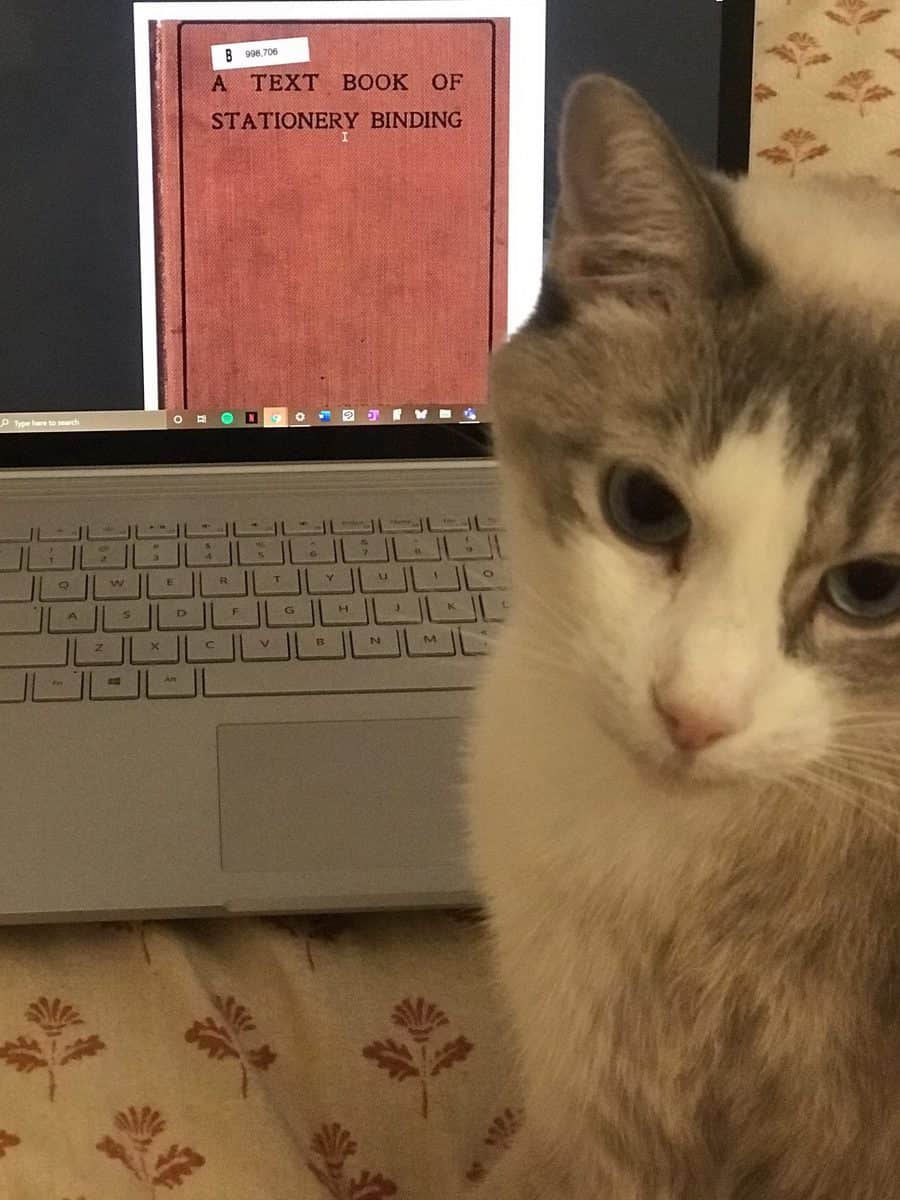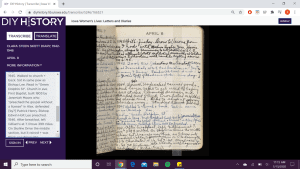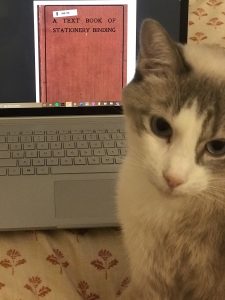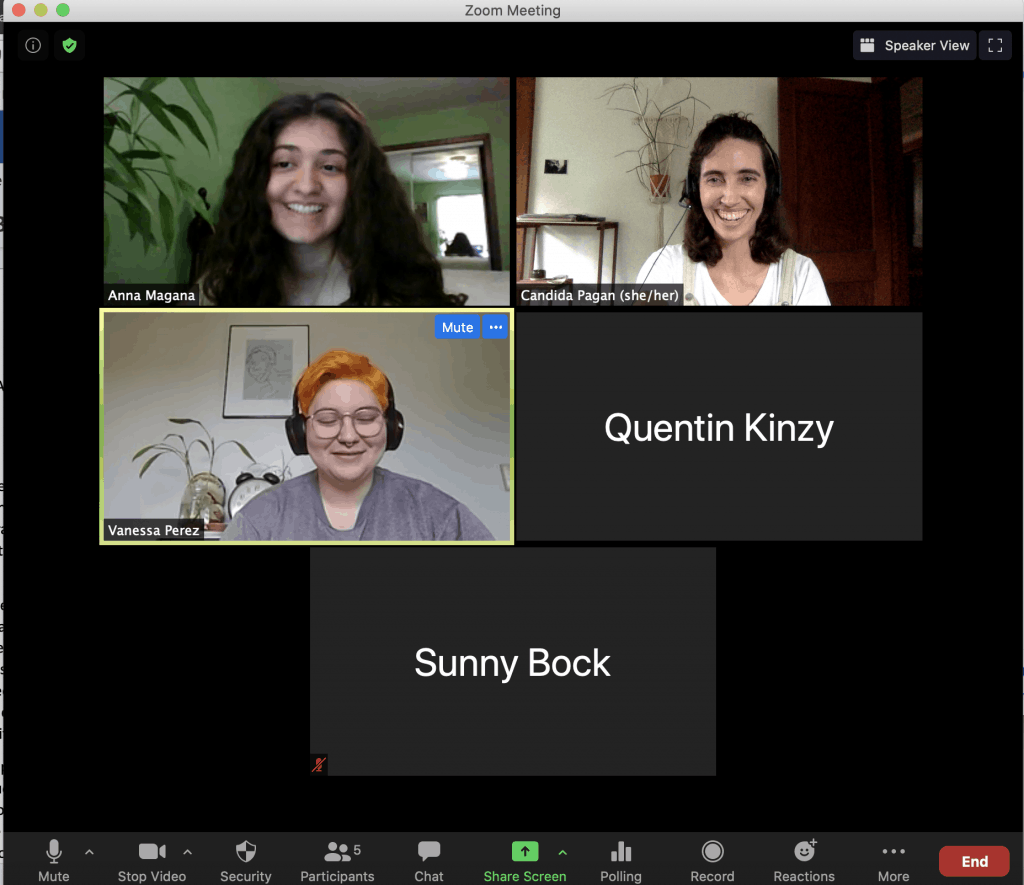
As part time interim Preservation Processing Coordinator in the UI Libraries Preservation Department, one of my main duties is to supervise the student staff who do the day to day marking work for new acquisitions and items that need to be reprocessed for one reason or another. From January to early spring of this year, we became accustomed to working with one another and revised workflows to adjust to the needs of the department. Mid-semester I felt we had reached a smooth operational flow; tending to marking, removing outdated information for remarking, shrink wrapping, preparing items for long term storage as needed, coordinating with circulating book repair to ensure unmarked spines had new titles, unpacking and routing recent returns from the bindery, processing items to get them into or back into circulation in a streamlined manner – it all seemed to be moving in stride. Cue the COVID-19 pandemic.
Just before and during the week of Spring Break, several students had intended to take time off and did so. Others intended to work more than usual – and were introduced to a new set of remote tasks. Department staff had quickly compiled several remote work options that could be performed online. With very short notice, the students were informed that they would not be returning to campus after break for classes, or for work. The COVID-19 pandemic response suddenly and necessarily disrupted campus life for the entire UI Community. Preservation student staff included. Like their peers, the students completed their semester online, and those who were able, continued their work for the department in a radically different way, entirely new to them. Four students who have continued to work through the summer share their experiences here. Thank you and cheers to you, Preservation & Conservation student staff for your flexibility, adaptability, and resilience.
Anna
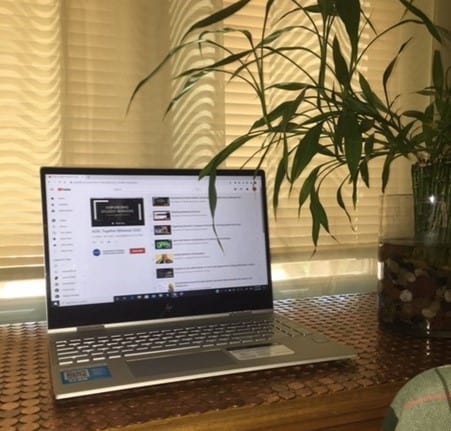
March of this year started in the way most months start, at least in Iowa City, so I still remember how odd it was to receive an email the Sunday before spring break letting me know not to come in the next day. I’ve been a student employee at the main library for two years now, and the experience has taught me about processes ranging from marking new materials to shrink wrapping old ones. These tasks, while often done alone, can feel collaborative when around my peers who are working on similar things. I also value the quiet but physical nature of doing things like marking books or re-shelving them; it is a nice way to focus my energy on my hands when so much of my schoolwork takes place on a computer.
Needless to say, transitioning to remote work has been an adjustment. With the guidance of my supervisors, I’ve worked on projects like cleaning up digital storage and transcribing archival materials. Admittedly, these tasks have taken some getting used to and it’s been a learning curve; this is to be expected. While I am learning new things, the things I’ve been assigned have been fairly comprehensive. The real adjustment for me comes with training myself to focus on a digital task for an extended period of time while the world feels so off-kilter and non-linear. I think a lot of people have felt the loss of structure that they would normally find in different environments.
While things are odd, I am grateful for the fact that I still have the opportunity to work at a time when so many people do not or cannot do so from the comfort of their homes. I do like to work with my hands, but there are other ways I can do that from home with other activities. The new tasks I’ve been given have also expanded my knowledge of library workings and have given me more appreciation for what goes on behind the scenes. In truth, remote work is a big change, but it is nice to have something to rely on right now and I am interested to see the what kind of remote projects will supplement our physical work in the fall.
Sunny
If I were visited while working at the Main Library (let’s say, back in January), you would have had no problem locating me at a computer, clicking or scanning and surrounded by carts full of books. If I were visited while working remotely now (let’s say, if it were safe), you would still see me sitting at a computer but in a less comfortable chair, without a barcode scanner and its continuous beeping, without a label printer or a barcode duplicator, without a printing station, without an assortment of paper cutting tools, and most noticeably, without any books. As a Student Marking Specialist, my main tasks used to involve working with physical materials and technology, but the transition into entirely remote work on my personal laptop has drastically reimagined my usual workflow and tasks.
In the library, I often encountered old and/or historical materials and books, but I usually didn’t engage with the content within these resources. Early in the transition to remote work, I spent many hours actually reading archival materials, transcribing the information, then later proofreading these transcriptions. I spent most of my time transcribing a Midwestern woman’s diary that she kept throughout the early 1910s through the 1940s, and I was struck with the overlooked value of local and historical artifacts as I read her entries. I started seeing names of towns in Iowa that I had never heard of, some of which are ghost towns now that you can still visit and see remnants of in some cases. I also began to comprehend the complex yet mundane nature of housewife life in these decades, and the complete restructuring of daily chores due to new technologies. In this way, I felt like I was learning new information while working, which is a very special experience.
One of my favorite parts of working at the library is seeing a wide array of books and their unique covers, but I have rarely followed-up with materials that looked interesting to me. My experience with remote work has reminded me of the value of libraries and how I should utilize my access to this incredible resource more often once back on campus. There are surprising things to learn in unexpected places, and I’m excited to return to the library with a renewed curiosity of the content of the materials that I process at the library. For now, I’m also extremely grateful to be able to work remotely.
Vanessa
Like many, the shift from the original format of work, classes, and life to our current digital routines has been strange for me. A handful of months ago I would have been stamping, taping, and marking away on books or happily creeping my way through the stacks with a cart full of periodicals to put away. The innate peacefulness of the library is appealing to me and I have always been the kind of person who values being able to work with my hands. Nowadays I spend most of my work time on my laptop. Though the physicality of working in the Main Library was often a big part of why I enjoyed it, the new mode of working is no less interesting. Whereas before I found satisfaction in the straightforward, hands-on tasks, now I engage more with the information that the library contains rather than the books that hold it.
All of this is not to say that this change has gone perfectly smooth for me. As I have mentioned, I am a very hands-on person– it felt like second nature for me to turn off my brain and tune in to good music or a podcast and after blinking I would have a stack of books marked and ready for the next step in the process. The lack of physical evidence of my work along with operating in my own home at my own pace can make it difficult to focus. The blurring of home and work means I often work at my kitchen table or occasionally sitting in my bedroom with my cat trying his hardest to join in on weekly video calls with coworkers.
Overall, my experience in this new way of working has been good. I’ve learned a lot about myself and what I value in my job, as well as a lot about the digital side to the library and all the historical records we have. While I certainly miss the old functions of my job, I’m glad to have been able to keep connected to my coworkers and look forward to seeing what work looks like as we move toward the fall semester.
Quinn
Between the environment, the hands-on tasks, the coworkers I have come to know, and the library collection I interact with, my job has really come to be one of the most rewarding experiences I have had at the university. Generally, I would walk into work, clock-in, say a quick hello to my coworkers, and grab a stack of books to start on. As a book-lover myself, it felt therapeutic to be both surrounded by books and constantly working with them.
When the shutdowns began, I had the privilege of still being employed by the libraries for the remainder of the spring semester and the summer, but the environment, coworkers, and collections I interacted with throughout the week, as you may expect, drastically changed. Instead of my pre-pandemic routine, I now usually grab a glass of lemonade before sitting down at the laptop in my childhood home to work on checking the archived university websites. I manually compare the archived versions with the live version of the site to check for any glaring differences, as well as click on all the links to make sure that the entire website and its content was correctly preserved.
Although I know the importance of maintaining our digital archives and find them very informative, I cannot tell you how much I miss working directly with books. There’s a certain kind of satisfaction to marking an entire row of books, knowing they could be in the hands of a reader so shortly. Online, most people won’t check the archives of a website from this year until major changes have occurred where someone would want to see the past versions.
I will say that I appreciate the opportunities that these changes have brought. For example, I wasn’t at all aware of the university digital web archive before I started working with it, and through this project, I have stumbled across work like the Art & Life in Africa website. This site compiles information on art from dozens of African cultures and puts the art into context of a piece’s local history and customs. There’s also Feminae, an index for content on medieval women, gender, and sexuality. Both sites would make fantastic resources for any research (as well as just being enjoyable to scroll through), and even though they are easily accessed through the university websites, free of any paywalls, I had no clue they were out there.
That being said, I still miss my previous job and my coworkers. I enjoy our weekly Zoom meetings to discuss any updates or struggles we have with these new tasks, and hopefully one day near in the future we can convene offline. I look forward to the day when healthcare professionals determine that it is safe to return to the libraries. Until then, I will be scouring the digital archives for errors, and hopefully in a few years, someone will find it interesting to look back on the university webpages during the pandemic of 2020.
